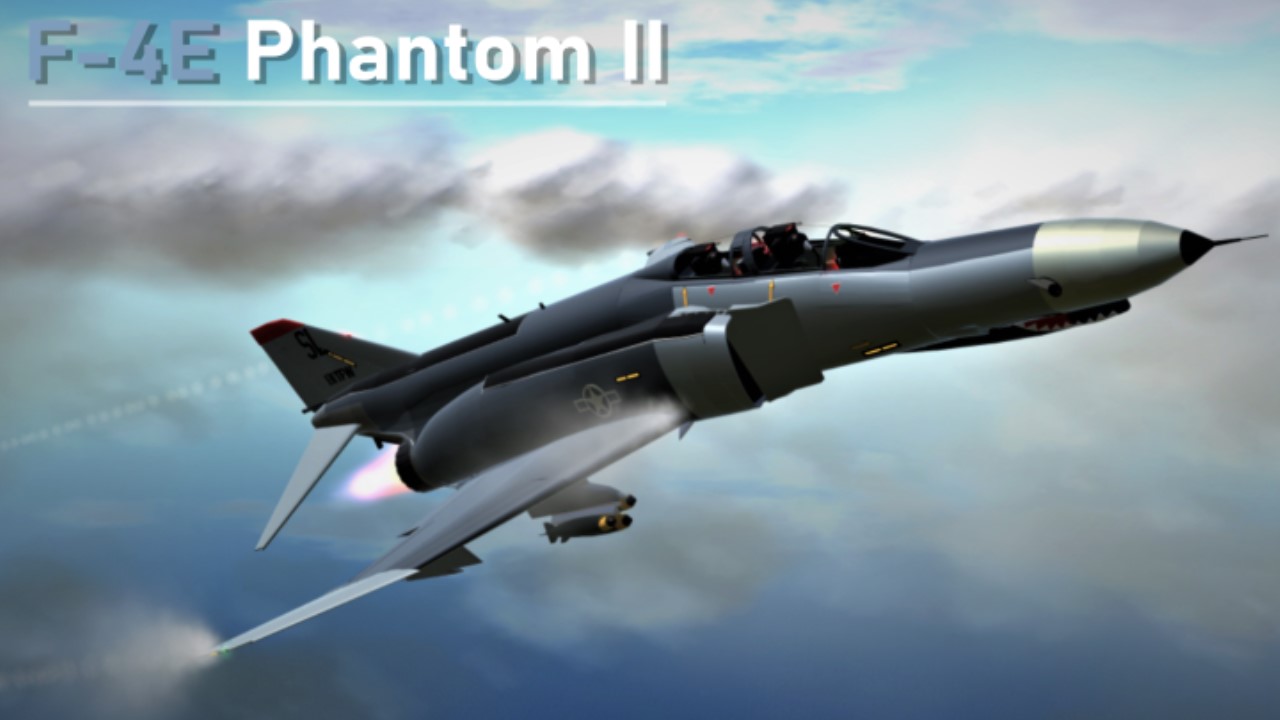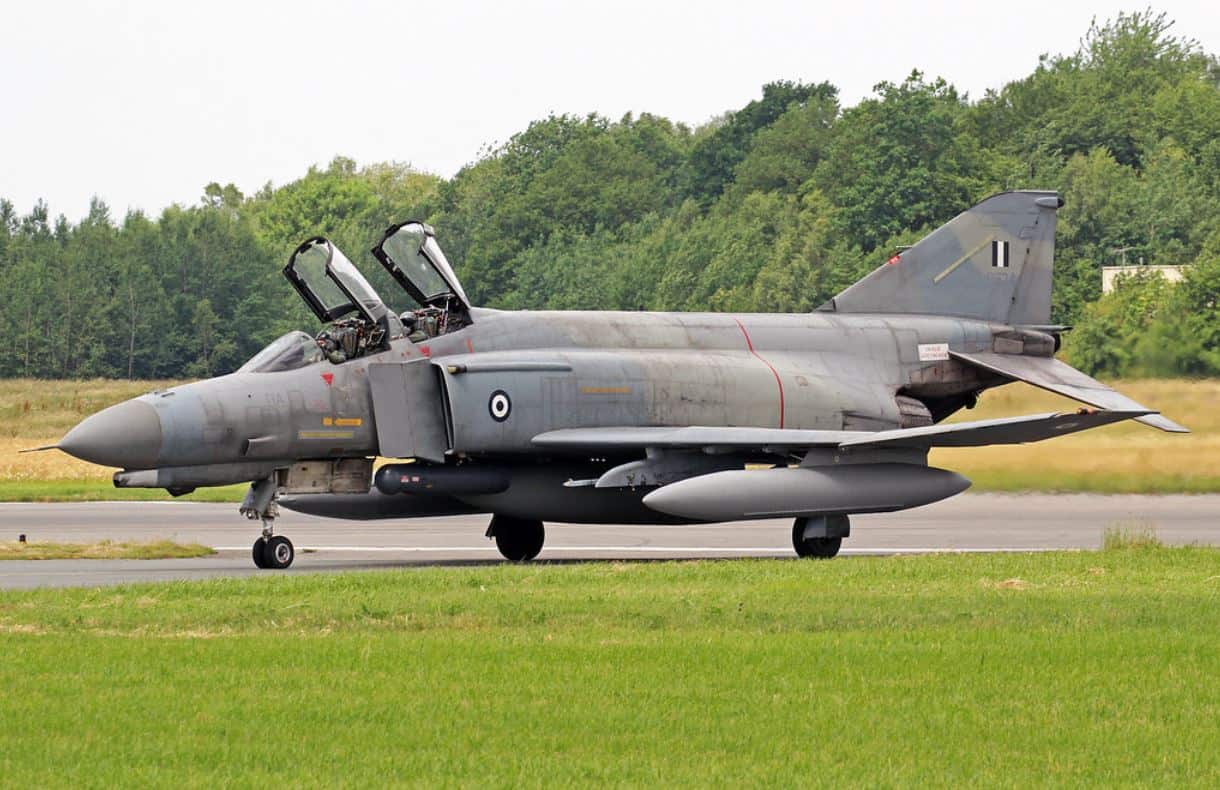F4 E Phantom - An American two-seat tandem, twin-gen, all-weather, long-range supersonic jet interceptor and fighter-bomber originally developed by McDonnell Aircraft for the United States Navy.
Before being adopted by the United States Navy and the United States Air Force, and by the mid-1960s it had become a major part of their aerial arsenal.
F4 E Phantom
Production of the Phantom continued from 1958 to 1981, with a total of 5,195 aircraft built, making it the most-produced US supersonic military aircraft in history, and solidifying its position as an iconic Cold War fighter.
F 4e Jv 268 Mig Killer
Phantom is a large fighter with a speed of over 2.2. It can carry more than 18,000 pounds (8,400 kg) of weapons on nine external hardpoints, including air-to-air missiles, air-to-surface missiles and various bombs. The F-4, like other interceptors of its time, was originally designed without an internal cannon. Later models used the M61 Vulcan swivel gun. Beginning in 1959, the aircraft set 15 world records for flight performance.
The F-4 was used extensively during the Vietnam War. It served as the primary air superiority fighter for the US Air Force, Navy and Marine Corps and became critical in ground attack and aerial reconnaissance roles late in the war. During the Vietnam War, a US Air Force pilot, two Weapons Systems Officers (WSO),
A US Marine pilot and a Radar Interceptor (RIO) were ace by getting five air strikes against their fighters.
The F-4 remained an important part of US military air power throughout the 1970s and 1980s, gradually being replaced by more modern aircraft such as the F-15 Eagle and F-16 Fighting Falcon in the US Air Force. 14 Tomcats in the US Navy, and F/A-18 Hornets in the US Navy and US Marine Corps.
Mcdonnell Douglas F 4c Phantom Ii > National Museum Of The United States Air Force™ > Display
The F-4 Phantom II was used by the United States in the 1991 Gulf War in the reconnaissance and Wild Weasel (Suppression of Amy Air Defense) roles, finally leaving service in 1996.
It was also the only aircraft used by both US flight demonstration teams: the United States Air Force Thunderbirds (F-4E) and the United States Navy Blue Angels (F-4J).
The F-4 is also operated by the armed forces of 11 other countries. Israeli ghosts saw extensive combat in several Arab-Israeli conflicts, while Iran used a large fleet of ghosts acquired before the fall of the Shah in the Iran-Iraq War. As of 2021, 63 years after its first flight, the F-4 remains in active service with the air forces of Iran, South Korea, Greece, and Turkey. The aircraft recently carried out operations against the Islamic State group in the Middle East.

In 1952, McDonnell's head of aerodynamics, Dave Lewis, was appointed by CEO Jim McDonnell as the company's initial design manager.
Aircraft Photo Of 68 0338 / Af68 338
In the absence of competition for the new aircraft, an internal study concluded that the Navy was in dire need of a new and different type of aircraft: the attack fighter.
In 1953, McDonnell Aircraft began revising its naval F3H demos, seeking increased capabilities and improved performance. The company developed several projects, including a variant powered by the Wright J67 milling engine,
The powerful version of the J79 promises a top speed of Mach 1.97. On September 19, 1953, McDonnell approached the US Navy with the "Super Devil" proposal. Uniquely, the aircraft was to be modular, as it could be equipped with one or two nose seats for different missions, different nose cones with radar, photo camera, four 20 mm (0.79 in) guns, or 56 FFRs. Guided rockets in addition to nine hard points under the wings and fuselage. The Navy was quite interested in developing a full-scale mock-up of the F3H-G/H, but felt that the Grumman XF9F-9 and the upcoming Vought XF8U-1 already filled the need for a supersonic fighter.
Accordingly, McDonnell's design was reworked into an all-weather fighter-bomber with 11 external hardpoints for armament and on 18 October 1954, the company received letters of intent for two YAH-1 prototypes. On May 26, 1955, four Navy officers arrived at McDonnell's office and within an hour, presented the company with a strict set of new terms. Since the Navy already had the Douglas A-4 Skyhawk for ground attack and the F-8 Crusader for dogfighting, the project now needed an all-weather fleet defense interceptor. Another crew was added to operate a powerful radar;
Zoukei Mura 1/48 Us F 4e Early Phantom Ii Sws 10
The XF4H-1 is designed to carry four semi-stealth AAM-N-6 Sparrow III radar-guided missiles, and is powered by two J79-GE-8 engines. As on the McDonnell F-101 Voodoo, the genes sit low in the fuselage to increase internal fuel capacity and trap air through fixed geometry intakes. The thin section wing has a leading edge sweep of 45° and is equipped with balloon shutters for better low-speed handling.
To avoid redesigning the aircraft's titanium fuselage components, McDonnell engineers bent only the outer wing by 12°, averaging the required 5° at the tip of the wing tire. The wings also got distinctive "dog teeth" for better control at high angles of attack. The all-movement tail plane is given a 23° anhedral to improve control at high angles of attack, while keeping the tail plane clear of engine exhaust.
In addition, the air intakes are equipped with a fixed ramp and a variable geometry ramp with a slope angle between Mach 1.4 and Mach 2.2 to provide maximum pressure recovery. Airflow mixing between inlet and intake is achieved with the exhaust as secondary air to the exhaust nozzle. All-weather interception capability is achieved with the AN/APQ-50 radar. To meet carrier operating requirements, the landing gear was designed to withstand landings at a maximum sinking speed of 23 ft/s (7 m/s), while the nose struts extended to 20 in (51 cm). can be increased. Attack on take-off catapult.

On 25 July 1955, the Navy ordered two XF4H-1 test aircraft and five YF4H-1 pre-production examples. The Phantom made its first flight on May 27, 1958 with Robert C. Little at the controls. Hydraulic problems prevented the landing gear from retracting, but the subsequent flight was much smoother. Initial testing resulted in redesigned air intakes, including the addition of 12,500 holes to "exhaust" slow-moving boundary layer air from the surface of each intake ramp. Series production aircraft also incorporated divider plates to divert boundary linings from the engine intakes. The aircraft immediately competed with the XF8U-3 Crusader III. Due to the cockpit workload the Navy required a two-seater aircraft and on 17 December 1958 the F4H was declared the winner. Delays in the J79-GE-8 engines meant that the first production aircraft were equipped with J79-GE-2 and −2A engines, each with 16,100 lbf (71.8 kN) afterburner thrust. In 1959, Phantom began carrier suitability testing with a complete launch-recovery cycle before release on February 15, 1960.
Mcdonnell Douglas F4 E Phantom Aircraft On Display At The Israeli Air Force Museum Editorial Stock Image
In D, the aircraft was given the less controversial name "Phantom II", the first "Phantom" being the second McDonnell fighter jet, the FH-1 Phantom. The Phantom II was briefly designated the F-110A and designated "Spectre" by the USAF, but it was not officially used.
Early in production, the radar was upgraded to the Westinghouse AN/APQ-72, AN/APG-50 with a larger radar antenna, which required a round nose, and the roof was reworked to improve visibility. could be improved and the rear cockpit made less cramped.
The USN F4H-1 (redesignated F-4A in 1962) was powered by J79-GE-2 and -2A engines thrusting 16,100 lbf (71.62 kN) and the building later received -8 engines. A total of 45 F-4As were built; None saw combat, and most were used as test or training aircraft.
The USN and USMC received the first definitive Phantom, an F-4B equipped with a Westinghouse APQ-72 radar (pulse only), a Texas Instruments AAA-4 infrared search and track pod under the nose, an AN/ AJB-3 Bombing System. and J79-GE-8, -8A and -8B with 10,900 lbf (48.5 kN) dry and 16,950 lbf (75.4 kN) afterburner (reheat) engines with first flight on 25 March 1961. 1961 and VF-121 Pacemakers found the first example at NAS Miramar.
Rokaf Loses Phantom Ii
The USAF acquired the Phantom as a result of Secretary of Defense Robert McNamara's efforts to create a unified fighter for all branches of the US military. After the F-4B won an "Operation High Speed" fly-off against the Convair F-106 Delta Dart, the USAF borrowed two Navy F-4Bs, temporarily designating them the F-110A in January 1962, and its own Fulfilled the requirements for version In contrast to the US Navy's focus on air-to-air interception in the Fleet Air Defense (FAD) mission, the USAF emphasized the air-to-air and air-to-ground fighter-bomber roles. On 18 September 1962, with the unification of the McNamara designation, the Phantom became the F-4, with the Navy versions designated the F-4B and the USAF F-4C. The first Air Force Phantom flew on May 27, 1963, exceeding Mach 2 on its maiden flight.
The F-4J enhances air and ground attack capabilities. Deliveries began in 1966 and ended in 1972 with 522 built.
Equipped with a J79-GE-10 engine with 17,844 lbf (79,374 kN) of thrust, a Westinghouse AN/AWG-10 fire control system (making the F-4J the world's first fighter jet).

F4 phantom model kit, f4 phantom for sale, diecast f4 phantom, f4 phantom shirt, e flite f4 phantom 80mm, f4 phantom toy, f4-e phantom, f4 phantom hats, e flite f4 phantom, f4 phantom, f4 phantom poster, f4 phantom t shirts
0 Comments